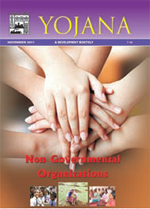
India is one of the fastest growing economies of the world. Yet the 2010 Human Development Index ranks India as a middle level country in the bottom third at 119 of 169 countries on the human development index. The world hunger index for 2010 indicates that India is home to 42 percent of the world’s underweight children. Similarly is the case when we consider education. Voluntary Organizations have been active partners in the fight to improve the livelihood of India’s poor for many years.
The voluntary sector or non-governmental organizations have emerged as a new force contributing to social upliftment and economic development. India is estimated to have 3.3 million registered NGOs. They play a vital role in the shaping and implementation of participatory democracy, and their credibility lies in the responsible and constructive role they play in society. They work at grassroots level in the remotest of areas and their reach is much wider. During the nineties the distinctive trend was the emergence of welfare oriented, non-profit and empowerment oriented organizations. NGOs emerged as important players in the development arena. The emerging NGO or voluntary sector is also known as the third sector.NGOs are engaged in development work in the remotest of areas in a variety of areas like health, education, water, environment, human rights, SCs/STs, Women empowerment, child rights, disability, etc., ensuring that people got their entitlements. Government has accepted role of NGOs in the development process. Many a time, NGOs act as a bridge between hard-to -reach areas and the government. Recognizing the important contributions made by this sector, in 2002 Planning Commission was declared the nodal agency for Government Organization - Voluntary Organization interface. This was the much needed step to have a focal point for an integrated and holistic view of the voluntary sector.
Read more..
